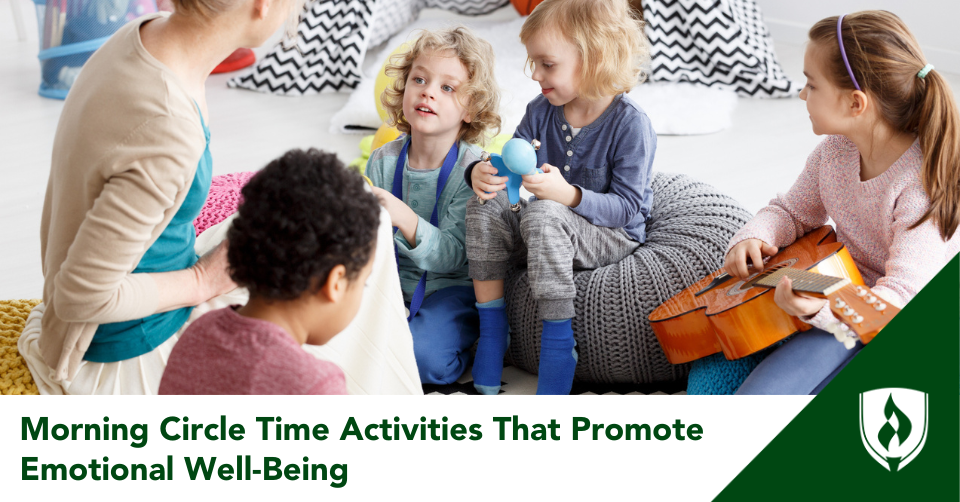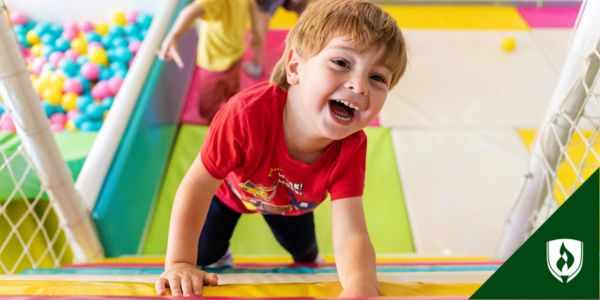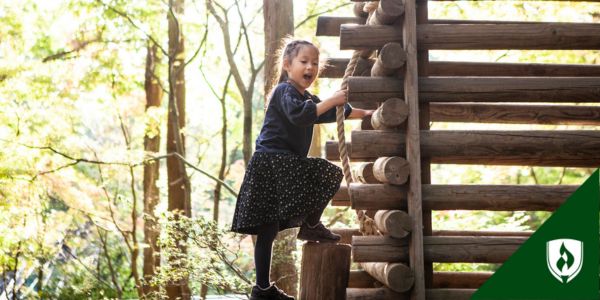Morning Circle Time Activities: Promoting the Emotional Well-Being of Our Kids
By Robbie Gould on 08/24/2023

Loading wiggles and giggles.... Preparing glitter drizzles and snack nibbles.
Circle time activities can be an absolute treasure trove of enriching experiences – far more than just your typical daily routine or good morning song. For kids, it's a magical time that can spark creativity, foster social skills, promote body awareness and ignite the love of learning.
Whether you're a seasoned daycare or preschool pro, new to the circle time scene or even early childhood education, this article is here to inspire you with fun, interactive circle time ideas that promote the emotional well-being of our adorable tiny tots. So, grab a seat on the floor and gather the kiddos – let's discuss how to make circle time a blast for everyone involved!
What is circle time and what should it include?
Daycare or preschool circle time ideas are meant to engage young children in an educational and interactive way.1 It is a structured group activity that generally lasts around 15-20 minutes, and it is commonly found in early childhood education settings such as preschools and daycare centers.
Typically, circle time involves daycare workers or preschool teachers gathering their entire class in a circle or semi-circle formation and having them participate in various group activities.
Most of these activities include songs, discussions, stories, and games as well as learning important social skills and concepts such as numbers, letters, colors and emotions. With creativity, you could have countless activities for a successful circle time.
What is its purpose?
The purpose of circle time is more profound than you would initially think. It encompasses several important goals in early childhood education all at once.1
One of the main purposes is promote social and emotional development.2 Circle time activities provide opportunities for children to practice important social skills such as taking turns, listening to others, sharing ideas and expressing themselves. It allows them to explore and understand their own emotions and the emotions of others through activities like discussions, storytelling, and role-playing.
Circle time also helps children develop oral language skills.3 During this time, children engage in conversations, share their thoughts and ideas, and listen to others. That participation enhances their vocabulary, comprehension and communication skills.
Circle time also nurtures and improves children's attention spans and listening skills. Sitting, paying attention, and participating in structured circle time activities help children to practice focusing their attention, follow instructions, and develop self-regulation skills.1
Lastly, circle time is also an ideal opportunity to reinforce academic concepts in a fun way. Through songs, stories, games, and discussions, children can learn about letters, numbers, shapes, colors, and other topics.4
Circle time games and ideas that promote children's well-being
The first few years are a crucial time for children's overall well-being and development.5 You'll need to keep in mind that each child is unique, so it will be essential to incorporate a variety of activities that cater to different interests and needs. The circle time activities you create have the potential to nurture children’s well-being and lay the groundwork for a healthy and happy life.
With that said, here are some activities that can support kids’ well-being.
1. Mindful moments
Introduce brief moments of mindfulness during circle time, encouraging children to focus on their breath and be present in the moment. These goals can be reached through simple breathing exercises or guided visualization, and they help to promote relaxation and control.
2. Yoga and stretching
Try encouraging children to perform gentle yoga poses and stretching exercises. These activities can contribute towards physical well-being and also promote mindfulness and body awareness. Comparing different poses to animals “stand like a flamingo!” can make the activity even more engaging.
3. Gratitude circle
Encourage your tots to express gratitude by taking turns sharing something for which they are thankful. This conversation may help children to develop a positive mindset; it also acknowledges their emotions and helps them cultivate empathy.
4. Nature walks
You could take the kids outdoors for nature walks or exploration sessions! Encourage them to observe, touch and smell their natural surroundings. This activity promotes a sense of connection with the environment, boosts their curiosity and helps them build social bonds.
Sensory circle time ideas and activities
1. Listen and walk
This activity teaches mindfulness and clear communication, which are two vital life skills. Take the kids out for a stroll in nature and challenge them to listen carefully to the sounds they hear.
As you walk, discuss the sounds – are they near or far? Are they man-made, natural or machine-made? Encourage them to stop often, close their eyes together and just listen to the world buzzing.
2. Texture scavenger hunt
Challenge your kids to find items with a variety of textures. These items can have various textures – bumpy, smooth, silky, fluffy, fuzzy, prickly, sticky, slippery, wiry, squishy, stretchy, lumpy, rocky, glossy, slimy or hairy. When they are finished, you can store the items in a "sensory box" for next time.
This sensory stimulation activity helps with cognitive development. It allows children to have the chance to use their observational skills and critical thinking skills to identify, differentiate, and match various textures.
3. Smell smorgasbord
Similar to the texture scavenger hunt, the smell smorgasbord can be a wonderful activity to engage children, encourage them to experiment and discover their sense of smell. It’s another way to help enhance their critical thinking and cognitive development.
In an organized manner, you could lay out a range of items with a variety of different scents. For instance, you could use coffee grinds, orange peels, cinnamon and other spices, or flowers.
During this activity, you could blindfold your kids and ask them to describe what they smell. Ask them what a scent reminds them of and if it's a good or bad smell. Challenge your kids to match a scent with pictures of the items.
4. Take a closer look
You could explore children’s sense of sight by making fake binoculars out of toilet paper rolls or having them safely navigate an area wearing a pirate's eye patch. Even better, bring in a magnifying glass and explore everyday objects!
You could bring in ordinary things like leaves, flowers, pond water, bark, fruit, veggies, candy, old coins, cloth or other items to explore. Ask kids to look at their hands and their fingerprints. Another option is to let the kids go outside and lie in the grass with their magnifying glasses; they'll love what they uncover!
5. Blindfolded taste test
Organize a blindfolded taste test among your kids and watch as the room swells with energy and excitement. You can do theme-related taste tests – using fruits, vegetables or desserts – or one big taste test that encompasses them all.
Tips to keep your kids engaged during circle time
Mix it up
Keep things fresh and exciting by incorporating a variety of activities for kids to enjoy. This approach will help you to capture their attention and cater to different learning styles.
Get them moving
Kids love to wiggle, so make sure to include movement-based activities (hands-on activities) during circle time. Incorporate actions, dance breaks, or even simple stretches to involve their bodies and keep their energy flowing.
Use props and visuals
Bring in props, puppets, or visual aids to add an extra dose of fun and enhance their understanding of a topic. Whether it's one child or the whole lot, a colorful prop, a captivating picture, or other visuals can spark imaginations and make activities more engaging.
Keep it interactive
Encourage active participation in circle time by giving children opportunities to share their ideas. Ask open-ended questions, invite them to share their experiences, or let them take turns leading a song or game. Their involvement will make them feel valued and keep their interest levels high.
Incorporate sensory elements
Engage their senses! Use scented play dough, textured objects, or musical instruments to stimulate their senses and make activities more engaging and memorable.
Keep it brief and dynamic
Young children have short attention spans. Ideally, aim for short, focused activities, and be prepared to switch gears if an activity causes children to lose interest.
Use positive reinforcement
Celebrate children’s efforts and achievements during circle time. Offer praise, high-fives or small rewards to acknowledge their active participation and engagement. This acknowledgement can keep children excited and encourage them to maintain focus.
Follow their lead
If a particular activity or topic is resonating with the children you’re teaching, build upon it and explore it further. Observe and respond to their interests and enthusiasm.
With these tips up your sleeve, you're ready to rock circle time and keep your kids excited and eager for more!
What topics are good to discuss during circle time?
When children join in a conversation, they build self-confidence and learn how to express themselves. Discussions, at times, can greatly support a child's development and well-being.
They can give children a chance to speak up, share their thoughts and learn to express themselves. Discussions can also lead to effective communication, the improvement of listening skills and so much more.1
Group discussions teach children to listen to others, respect different ideas and see things from different perspectives. They get to ask questions, think critically and figure out ideas together.
And of course, a group discussion provides a safe space where everyone's voice is valued and respected. Here are some topics to guide your circle time discussions.
Emotions and feelings
Children should be able to understand and express their emotions. In a group conversation, discuss different emotions, what causes them and how to manage them effectively. Encourage empathy and create an open, safe environment for children to share their feelings.
Friendship and cooperation
In discussions, you can discuss what it means to be a good friend, how to resolve conflicts peacefully and why teamwork is important. Explore the concepts of friendship, kindness and cooperation with your kiddos.
Diversity and inclusion
Try discussing topics related to diversity, such as cultural traditions, languages and different abilities. Encourage acceptance, respect and appreciation for everyone's unique qualities. Using this strategy could contribute to creating an environment that embraces inclusivity and celebrates diversity.
Nature and the environment
You could teach children about the wonders of nature and the importance of taking care of the environment. For example, aim to discuss topics like plants, animals, seasons and sustainability. You could also consider incorporating nature walks or gardening activities.
Health and hygiene
Discussing topics like nutrition, exercise, personal hygiene and the importance of handwashing can help in promoting healthy habits. Teach children the basics of staying healthy and taking care of their bodies.
More topics to discuss:
- Time, numbers and counting skills
- Letters and sounds
- Holidays and traditions
- Personal development
- Careers/roles of society/community
Now it's your turn to lead circle time activities!
Circle time is an invaluable component of early childhood education that offers a multitude of benefits for children's well-being and development. Through fascinating activities including discussions and interactions with other students, circle time creates a sense of community, fosters social-emotional skills, promotes academic readiness and enhances cognitive development and language skills.
If you're interested in learning more about a career in early childhood education, consider Rasmussen University’s Child Development Associate (CDA) Credential training. This well-rounded foundation in child development can give you tons of ways to nurture growth in practical ways. Check out our articles " Daycare vs. Preschool: The Go-To Guide for Parents" and "Early Childhood Mental Health: 8 Things ECE Professionals Should Know".
Related Articles:
Rasmussen University ECE programs do not prepare students for licensed teaching positions in any public school setting, but students will have the opportunity to help shape the futures of young children from birth to age six in a childcare or non-public school setting or leadership role.
1Children’s Corner Group Staff. Children’s Corner Group. 8 Benefits of Circle Time to Preschoolers. Date accessed 7/14/23. https://www.childrenscornergroup.com/benefits-of-circle-time-to-preschoolers/
2Office of Child Development and Early Learning. Using Circle Time to Promote Social-Emotional Skills. Date accessed 7/14/23. https://s35729.pcdn.co/wp-content/uploads/2021/01/ECMH_UsingCircleTime.pdf
3PBS Learning Media. Oral Language and Vocabulary - Circle Time. Date accessed 7/14/23. https://www.pbslearningmedia.org/collection/circle-time-at-home/t/oral-language-and-vocabulary-circle-time/
4V Levin. Pre-Kpages. The Best Preschool Circle Time Tips. Date accessed 7/24/23. https://www.pre-kpages.com/circle_time/.
5U.S. Department of Health & Human Services – Center for Disease Control. Child Development Basics. Date accessed 7/24/23. https://www.cdc.gov/ncbddd/childdevelopment/facts.html.




